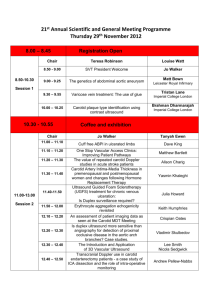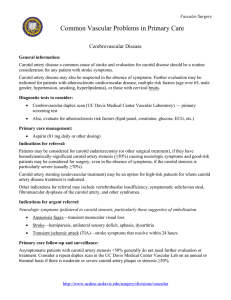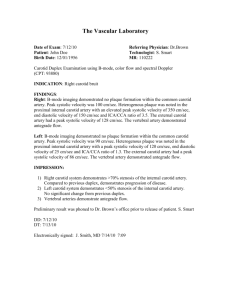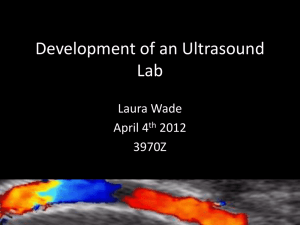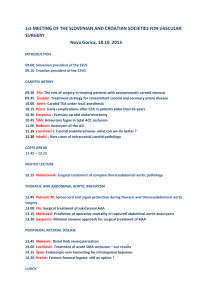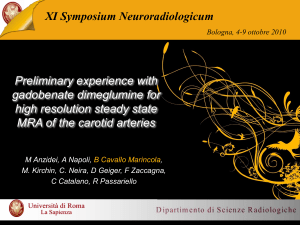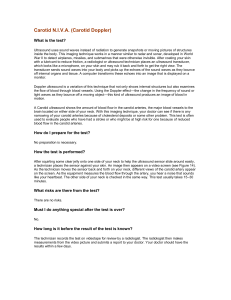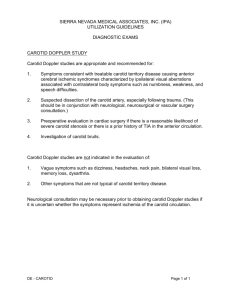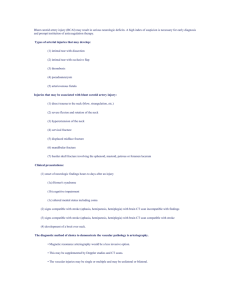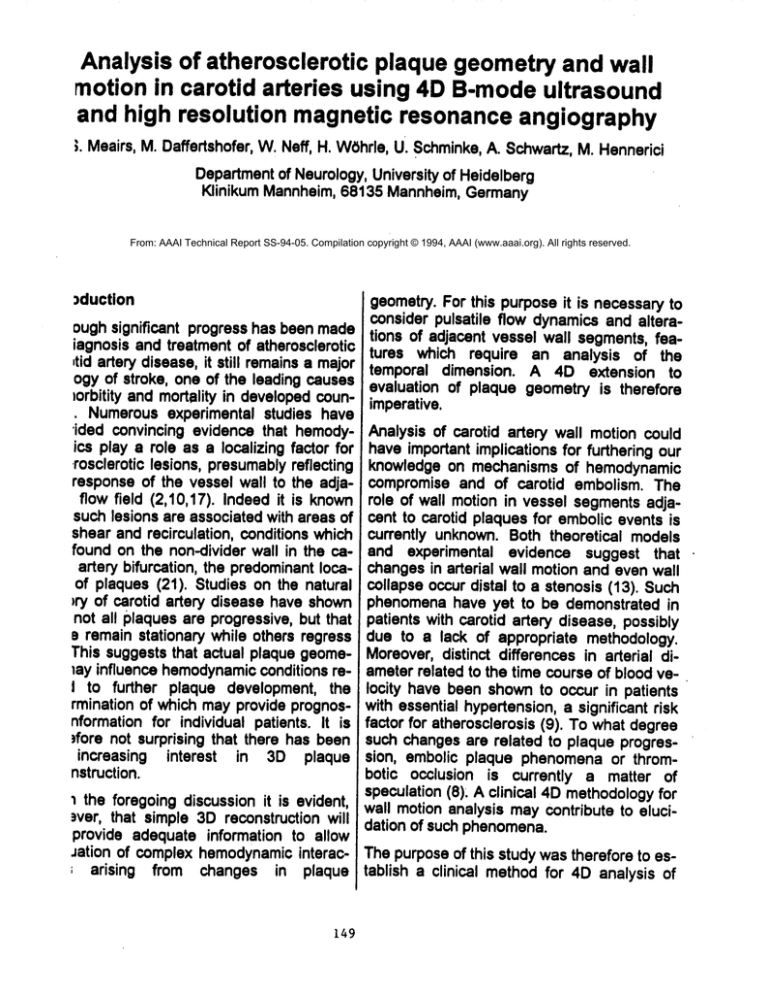
Analysis of atherosclerotic plaque geometryand wall
motionin carotid arteries using 4D B-mode
ultrasound
and high resolution magneticresonanceangiography
;. Meairs,M. Daffertshofer, W.Neff, H. W6hrle,U. Schminke,
A. Schwartz,M. Hennerici
Department
of Neurology,University of Heidelberg
Klinikum Mannheim,68135 Mannheim,Germany
From: AAAI Technical Report SS-94-05. Compilation copyright © 1994, AAAI (www.aaai.org). All rights reserved.
)duction
geometry.For this purposeit is necessaryto
consider pulsatile flow dynamicsand alteraoughsignificant progress has beenmade
tions of adjacent vessel wall segments,feaiagnosis andtreatmentof atherosclerotic tures which require an analysis of the
,tid artery disease,it still remainsa major
temporal dimension. A 4D extension to
ogy of stroke, one of the leading causes evaluation of plaque geometryis therefore
Iorbitity andmortality in developed
counimperative.
Numerousexperimental studies have
’ided convincing evidence that hemody- Analysis of carotid artery wall motion could
ice play a role as a localizing factor for haveimportantimplications for furthering our
rosclerotic lesions, presumably
reflecting knowledge on mechanismsof hemodynamic
responseof the vessel wall to the adja- compromiseand of carotid embolism. The
flow field (2,10,17). Indeedit is known role of wall motionin vessel segmentsadjasuchlesions are associatedwith areasof cent to carotid plaquesfor emboliceventsis
shear andrecirculation, conditions which currently unknown.Both theoretical models
found on the non-divider wall in the ce- and experimental evidence suggest that
artery bifurcation, the predominant
Ioca- changesin arterial wall motionandevenwall
of plaques (21). Studies on the natural collapse occurdistal to a stenosis (13). Such
)ry of carotid artery diseasehaveshown phenomena
have yet to be demonstrated in
not all plaquesare progressive,but that patients with carotid artery disease,possibly
e remainstationary while others regress due to a lack of appropriate methodology.
This suggeststhat actual plaque geome- Moreover,distinct differences in arterial dilay influence hemodynamic
conditions re- ameterrelated to the time courseof bloodveI to further plaque development, the locity have beenshownto occur in patients
rmination of which mayprovide prognos- with essential hypertension,a significant risk
nformationfor individual patients. It is factor for atherosclerosis(9). To whatdegree
)fore not surprising that there has been such changesare related to plaque progresincreasing interest in 3D plaque sion, embolic plaque phenomena
or thromnstruction.
botic occlusion is currently a matter of
speculation(8): A clinical 4Dmethodology
for
the foregoingdiscussionit is evident, wall motionanalysis maycontribute to eluci)ver, that simple 3Dreconstruction will
dation of such phenomena.
provide adequateinformation to allow
Jation of complexhemodynamic
interac- Thepurposeof this study wastherefore to es; arising from changes in plaque tablish a clinical methodfor 4Danalysis of
149
atherosclerotic plaques, pulsatile dynamics to define volumesof presaturation, so that the
andwall motionin carotid arteries to serveas signal of flowing volumeleads to the formaa platform for investigations with finite ele- tion of a bolus, whosespatial and temporal
evolution can be followed.
mentandfinite difference methodology.
Oneprerequisite for numericalsimulation of Methods
bloodflow in carotid arteries is an exact geometry. For this purposeB-modeultrasound, Parallel B-modeultrasound scans of the caa noninvasiveand routine clinical technique rotid artery (slice distance 2 mm,resolution
0.17 mmx 0.5 ram) triggered by presampled
whichoffers excellent display of carotid arteries, is the imagingmethodof choice. Moreo- ECGR waves(10 frames per cardiac cycle)
ver, considerable progress has beenmadein were achieved with a 7.5 MHzlinear array
probe (Acuson) and a mechanicalstep motor
the field of 3Dultrasoundover the last several years (5,14,18) andreports on 3Dplaque (TomographicTechnologies) in normal subreconstructionat the carotid bifurcation have jects and in patients with carotid artery
plaques.
shown
the feasibility of this technique(20).
The importance of pulsatile flow upon fea- For segmentation of the 4D data set Gaussian convolutions were implementedto retures such as separation, secondaryflow and
duce
artifacts, particularly those due to
flow disturbances has beenelegantly demonstrated with hydrogenbubbleflow visualiza- reverberation. Lateral shadowingwas manually removed and those portions of the
tion and laser-Doppler-velocimetry (10,11).
Thequestion of whichfunctional imagingpro- touched image were markedfor exclusion in
cadureis best suited for providing pulsatile wall motion analysis. A nearest-neighbor
flow information for integration with morpho- thresholdedclassification algorithm wasthen
logical data fromultrasoundis not easily an- used to segment the preprocessed data.
swered. The necessity of obtaining an Plaquesegmentationinvolved additional defiaccurate insonation angle makesDoppler a nition of regionof interest.
poor choice for 3Dexamination,while this an- Themagnitudeand direction of carotid artery
gle will be constantly changingduring the wall motion was measuredby comparison of
procedure. Morepromising seemsto be the segmented
ultrasound axial slices over time.
combination of B-modeultrasound with new Areas where manual segmentation was emmagnetic
angiographic ployed weredisregardedin the analysis.
resonance
techniques.
High resolution MRangiography utilizing
Numerousmethodsusing MRfor determina- magnetizationtransfer suppressionand tilted
tion andevaluationof bloodflow velocity and optimized non-saturatedexcitation technique
volumeflow have beendescribed. Nearly all was performed using a Siemens Magnetom
of thesetechniquesfall into two categories; 63 SP 1.5 T magnet system. For MRbolus
first phasecontrast (PC) methods(changes
tracking cardiac-triggered gradient echo
proton phase dependenton flow velocity),
pulse sequences
with additional presaturation
and time-of-flight (TOF)related methods. pulses (TR/TE/flip/FOVI matrix/Aq. - 95msl
newmethod,dynamicMRbolus tracking, is a 20ms/ 30deg/ 230mm/ 160"2561 1, 40ms/
combinationof MRflow presaturation and MR 10ms/30deg/200ram/256"2561
1), partly in
cine angiographyfor measurement
of flow ve- multi-echo techniquewith a section thickness
locity (3,16). It is basedon gradient-echo of 10 mmwere accomplished. These sepulse sequenceswith cardiac triggering,
quenceswere used for acquisition of 32 imsmall flip angleandshort repetition time, in ageswithin the cardiac cycle. Flow velocity
which signal suppressionthrough presatura- was calculated by measuringthe distance of
tion results in a very lowsignal intensity in the the spatial inflow of bright bloodinto the userensuing images. This technique can be used
150
defined rectangular presaturation volume
over the interval of time between
the presaturation and the image acquisition. These
measurements
allow calculation of peak flow
velocities in systolic-diastolic modulation.
Eachdata point in these spectra represents
oneinflow measurement
at a definite time in
the cardiac cycle. Volumeflow can then be
calculatedby fitting the approximate
parabolic
velocity flow profile andthree-dimensional
integrationof the spatial inflow overthe time interval betweenpresaturation andacquisition
:~f each of the 32 measurements
after the
ECGR-wave.
Matchingof the velocity flow profile obtainec
’rom bolus tracking to the segmented
4Dul:rasound data set was accomplishedthrough
segmentationof the MRA
data with a nearest~eighborclassification algorithm, data scalng, andcenter line registration betweenseg"nentedultrasoundandMIRAcarotid arteries.
l’his consequently
enabledregistration of the
aolustracking data to ultrasound.
motion. Wall motion was best appreciated
with the isosurfacereconstruction.
Segmentationof MRAdata sets proved to be
a relatively straightforward task. Centerline
registration of bolustracking velocity profile
information to ultrasound data wasachieved,
although the accuracy of this method was
questionable due to problems encountered
with ultrasoundsegmentation.
Discussion
Theresults of this studyshowthat 4Dultrasoundis capableof delivering useful information on plaquegeometry.Moreover,this
methodcan detect changesin wall motion, althoughthis feature is limited by problemsof
imageacquisition primarily arising fromartifacts. Theseproblemsmight be overcomeby
employinga six degreeof freedomelectromagnetictracking device instead of a mechanical step motor. Althoughthe problemof
reconstructionis quite complexfor 6DOF,significant progresshas beenmadein this area
(5). Anotherapproachmight be to consider
the implementation
of B-spline algorithmsfor
segmentationpurposes(6).
Volumerendering and surface reconstruction
wasperformedwith the Application Visualiza:ion System(AdvancedVisual Systems,Inc.)
an a HP715-50CRX24Z
workstation. Visuali- Thepulsatile bloodflow througha 3Darterial
.,ation of wall motion wasachievedthrough bifurcation can be described by the timeanimationof. isosurfacereconstructions.
dependent3D Navier-Stokes equations. The
numericalsolution of these equations, an arResults
duouscomputertask, makesuse of either firhe described technique provides excellent nite difference or finite elementapproaches.
lisualization of 4D plaque geometry. The While each method has its advantages and
~isualization of adjacentwall segments,how- disadvantages,it seemsthat a finite differ~ver, waspoor due to shadowingcausedby ence method applied on a finite element
)laquecalcification.
meshmayprovide the best overall results
3egmentation
provedto be a tedious task for (15).
Jltrasound data as it required viewing each Early work in numerical simulation of flow
.~D imageslice individually for manualre- adoptedhighly simplified symmetricmodels
~oval of lateral shadowsand extremerever- while later effort wasdevotedto geometric
berationartifacts.
modelingof the carotid bifurcation basedon
biplanar angiograms(1). Numerical studies
:results showdifferences in wall motility in
)atients with symptomaticplaques. This was dealing with flow in an asymmetric three)articularly evidentdistal to the stenosisand dimensionalbifurcation with complexgeometry are limited andthere havebeenno reports
)ccurredpredominantly
on the wall of the flow
on using such methodologyin a clinical setJivider. Thewall adjacentto the flow divider
ting. Likewise, only a few studies have
tnd just distal to the stenosisshowed
little
15l
consideredthe effect of wall elasticity and 10. Ku D, GiddensD, Jadus C, Glegov S: Pulsatik
non-Newtonian
viscoelasticity of blood on flow and atheroosderoslsin the humancarotid bifuroe
tion. Atherosclerosis,5:293-302,1985.
flowfields at bifurcations(19,12). Thesehave
demonstrated
substantialdifferencesof sec- 11, Ku D, Giddens D: Laser Doppler anemomete
of pulsatile flow in a modelcarotid bi
ondaryflows andflow separationbehindthe measurements
furcation. J Biomech20:407-421,1987.
bifurcation as compared
to modelsnot incorporatingthesefeatures.
12. Ku D, LiepschD. Theeffects of non-Newtonlan
via
coelastlcity andwall elasticity on flow at a 90" bifurca
It is obviousthat numericalsimulationof tlon. Biorheology23:359-370,1986.
bloodflow usingclinical datafromultrasound!3. Ku D, Zeigler M, BinnesR, Stewart M: A study o
andMRbolustrackingwill be a difficult task. predicted and expedmentalwall collapse in modelso
This endeavor,however,is certain to provide highly stenotic artedes. Proc. Biofluid Mechanics
valuableinsightsinto the pathophysiology
of 409-418,1990.
stroke andatherosclerosisandwill continue 14. LaloucheRC, BickmoreD, Tessler F, Mankovicl
to be a central area of research at our HK, KangarelooH: Threedimensional reconstructiof
of ultrasoundImages,Proc. SPIE89, 59-66, 1989.
institution.
References
1. BheredvaJB, MabonR, GiddensD: Steadyflow In a
modelof the human
carotid bifurcation. Part II-Lassr
Doppler anemometer measurements. J Biomech
15:383-378,1982.
15. LoogsdaleR. An algorithm for solving thermal
hydraulic equations in complexgeometry. The ASTEC
code. UKAEA,Dounreay, 1988.
18. Mettle H, EdelmannRR, WentzKU, Reis MA, At
kinsonDF,Ellert T. Middlecerebral artery: determine
tion of flow velocities with MRangiography.Radiology
2. CamCG, Fitz.Gerald JM, Schroter RC: Atheroma 181:527-530,1991.
and artedal wall shear:, observation, correlation and
proposal of a shear dependentmasstransfer mecha- 17. Meairs S, Weihe E, Mittmann U, ForssmannWG
nism of atherogenesls.Pro¢ R Soc178:109-159,1971. Location and Morphologyof Hypertensive Lesions if
CoronaryArtedesof Dogs.In: Fluid Dynamicsas a Lo
3. EdelmanRR,Mettle H, Kleefeld J, Silver MS.Quan- calizing Factorfor Atherosclerosis:173-181,1983.
tification of blood flow with dynamicMRimagingand
presaturation bolus tracking. Radiology,171:551-556, 18. OhbuchiR, ChenD, FuchsH: Incremental volum¢
reconstruction and rendering for 3D ultrasound imag
1989.
ing. Proc. SPIEVisualization in BiomedicalComput.
4. Forster F, ChikosP, Frezler J: Geometri(:modelling ing, 312-323,1992.
of the carotid bifurcation in humans:
implicationsin ulblood flow simulatior
trasonic Dopplerandradiologic Investigation. J Clin Ul- 19. Perktold K: Non-newtonlan
and
wall
shear
stress
in
an
artedal
bifurcation. Proc
trasound13: 385-390,1985.
Blofluid Mechanics,471-477,1990.
¯ 5. Ganapathy
U, KaufmanA: 3Dacquisition and visualization of ultrasounddata. Proc. SPIEVisualization 20. Steinke W, HennedciM: Three-dimensionalultr&
soundimaging of carotid artery plaques. J. Cardk>
in BiomedicalComputing,535-545,1992.
vasc. Technology8:15-22, 1989.
8. Guezlec A, AyacheN: Smoothingand matching of
3.D space curves. Proc. SPIEVisualization in Bio- 21. Zadns CK, GiddensDP, Bharadvaj BK et el: Ca.
rotid bifurcationsatherosclerosis:quantitative correla.
medical Computing,259-273, 1992.
tion of plaquelocalization with flow velocity profile:
7. HennedciM, Steinke W.: Carotid plaque develop andwall shear stress. Circ Res53: 502-514,1983.
ments: aspects of hemodynami¢and vessel wallplatelet interaction. Cerebrovasc
Dis 1:142-148,1991.
8. HennedciM, RautenborgW, Trockel U, et al: Spontaneousprogression and regression of small carotid
atheroma.Lancet1985b;i:1415-1420.
9. JonesC, CarDC: Thepotential importanceof artedal wall propertiesandbloodflow in relation to atherogenesis in essential hypertension. Proc. Biofluid
Mechanics,109-112,1990.
152


